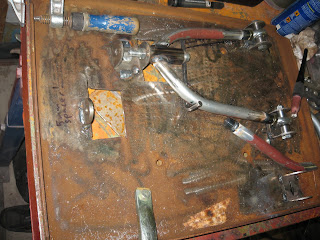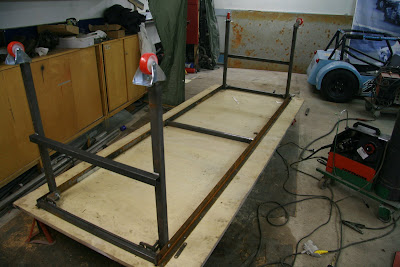Now that we had the frame on the table, we decided to attach the suspension mounting points.

Connecting the front suspension mounts to the frame. The right height was measured with a angle square.
When positioning the front suspension brackeets, we put the car straight compared to the jig table, and then positioned the suspension mounts according to the jig table. In both frames we had a couple millimeters misalignment, and even though the second frame is much better than the first one, the "nose square" is a couple millimeters too much forward on the upper left corner. When we position the suspension brackets according to the jig table, the errors of the frame won't affect the accuracy of positioning the suspension brackets.
Etujousitus työn alla. Korkeus mitattiin suorakulmalla.
Etujousitusta tehdessä meillä on laitettu auto suoraan verrattuna jigipöytään ja jousitus on tehty jigipöydän mukaan. Molemmissa rungoissa on ollut muutama milli heittoa, ja vaikka Mikan runko on parempi kuin eka runko, niin esim. keulaneliö on vasemmasta etureunasta muutaman millin liian edessä. Kun jousitus tehdään jigipöydän mukaan ja mitataan keskelle, saadaan jousituspisteet tarkasti paikoilleen vaikka runko olisikin vähän kiero.

We were very surprised to get the suspension mounts perfectly aligned. Last time we used 10mm threaded rod to align the mounts compared to each other, it wasn't very accurate. This time we had a 10mm steel rod. After welding you could easily push the rod through both mounts and it just felt perfect. We chose rod ends originally because we didn't believe we could align the suspension mounts good enough when using urethane bushings. Using rod ends gives a weight penalty of 3%, but at the time we thought it was worth it.

As you probably notice from the above picture, we did the suspension a bit in the wrong order. In the previous car we did the lower front suspension mounts first, and then the upper ones. Doing the upper ones first means that you have to weld the FU tube in way of the rod so we couldn't perfectly align the suspension mounting brackets.

The rear suspension mounts. We decided to raise them a little so that the rear suspension arms would be level when the car is at the right ride height. I had to check this many times because the difference was so big that it felt just wrong. You can see the old mounting points in the picture.
 How the shifter linkage attaches to the engine.
How the shifter linkage attaches to the engine. Looking forward from the shifter.
Looking forward from the shifter. The shifter. We will still have to incorporate the "clutch press while downshifting" into the shifter mechanism. This time we will be running with a separate clutch pedal, but we're planning to use it only when driving in the pits or starts.
The shifter. We will still have to incorporate the "clutch press while downshifting" into the shifter mechanism. This time we will be running with a separate clutch pedal, but we're planning to use it only when driving in the pits or starts.










































